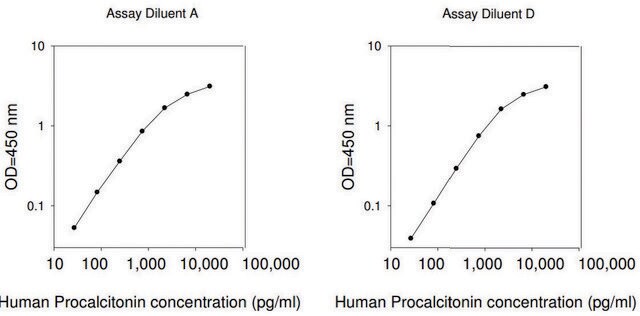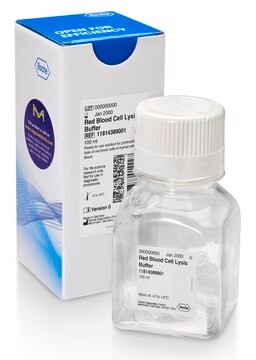RAB0007
Human RAGE / AGER ELISA Kit
for serum, plasma, cell culture supernatant and urine
Zaloguj sięWyświetlanie cen organizacyjnych i kontraktowych
About This Item
Kod UNSPSC:
41116158
NACRES:
NA.32
Polecane produkty
reaktywność gatunkowa
human
opakowanie
kit of 96 wells (12 strips x 8 wells)
metody
ELISA: suitable
capture ELISA: suitable
moc wejściowa
sample type cell culture supernatant(s)
sample type plasma
sample type serum
sample type urine
assay range
inter-assay cv: <12%
intra-assay cv: <10%
sensitivity: 3 pg/mL
standard curve range: 2.06-1500 pg/mL
metoda wykrywania
colorimetric
Warunki transportu
wet ice
temp. przechowywania
−20°C
informacje o genach
human ... AGER(177)
Powiązane kategorie
Opis ogólny
Zestaw Human RAGE ELISA (Enzyme-Linked Immunosorbent Assay) to test immunoenzymatyczny in vitro do ilościowego pomiaru ludzkiego RAGE w surowicy, osoczu, supernatantach hodowli komórkowych i moczu.
Immunogen
Rekombinowany ludzki RAGE
Zastosowanie
Wyłącznie do użytku badawczego. Nie stosować w procedurach diagnostycznych.
Ludzki zestaw RAGE / AGER ELISA został użyty do ilościowego pomiaru RAGE w płynie mózgowo-rdzeniowym.
Należy zapoznać się z załączonym ogólnym zestawem ELISA Procedura (kanapkowy, konkurencyjny i pośredni test ELISA).
Ludzki zestaw RAGE / AGER ELISA został użyty do ilościowego pomiaru RAGE w płynie mózgowo-rdzeniowym.
Należy zapoznać się z załączonym ogólnym zestawem ELISA Procedura (kanapkowy, konkurencyjny i pośredni test ELISA).
Działania biochem./fizjol.
Receptor specyficzny dla zaawansowanych produktów końcowych glikozylacji (AGER) lub RAGE jest częścią nadrodziny immunoglobulin cząsteczek powierzchniowych komórek. Rozpuszczalna forma białka pełni funkcję w szlaku Wnt. RAGE odgrywa rolę w rozwoju stanu zapalnego i uszkodzeń komórkowych, a także toksyczności komórkowej. Zostało to powiązane z miażdżycą cukrzycową. AGER/RAGE moduluje również proliferację, różnicowanie i apoptozę komórek.(6}
Inne uwagi
Dla tego produktu dostępny jest przykładowy certyfikat analizy.
Wpisz słowo sample w polu tekstowym przeznaczonym na numer partii.
Wpisz słowo sample w polu tekstowym przeznaczonym na numer partii.
Ta strona może zawierać tekst przetłumaczony maszynowo.
Elementy zestawu są też dostępne oddzielnie
Numer produktu
Opis
Karta charakterystyki
- RABELADAELISA 1X Assay/Sample Diluent Buffer A (Item D1)Karta charakterystyki
- RABELADBELISA 5X Assay/Sample Diluent Buffer B (Item E1)Karta charakterystyki
- RABSTOP3ELISA Stop Solution (Item I)Karta charakterystyki
- RABTMB3ELISA Colorimetric TMB Reagent (HRP Substrate, Item H)Karta charakterystyki
- RABWASH420X Wash Buffer (Item B)Karta charakterystyki
Hasło ostrzegawcze
Warning
Zwroty wskazujące rodzaj zagrożenia
Zwroty wskazujące środki ostrożności
Klasyfikacja zagrożeń
Met. Corr. 1
Kod klasy składowania
8A - Combustible corrosive hazardous materials
Wybierz jedną z najnowszych wersji:
Masz już ten produkt?
Dokumenty związane z niedawno zakupionymi produktami zostały zamieszczone w Bibliotece dokumentów.
An inverse association between serum soluble receptor of advanced glycation end products and hyperandrogenism and potential implication in polycystic ovary syndrome patients
Yu Liao
Reproductive Biology and Endocrinology, 15, 9-9 (2017)
Increase of Soluble RAGE in Cerebrospinal Fluid following Subarachnoid Haemorrhage
Bartosz Sokol
BioMed Research International (2017)
Association of Polymorphisms of the Receptor for Advanced Glycation Endproducts Gene with Schizophrenia in a Han Chinese Population
Jiawu Fu
Biomedical Research, 6379639-6379639 (2017)
Association of RAGE gene Gly82Ser polymorphism with coronary artery disease and ischemic stroke
Wen-Qi Ma
Medicine, 95(49), e5593-e5593 (2016)
Zhi-hong Wang et al.
Molecular nutrition & food research, 58(7), 1426-1435 (2014-03-04)
Antiglycative effects of glycyrrhizic acid (GA) in kidney of diabetic mice were examined. GA at 0.05, 0.1, and 0.2% was supplied to diabetic mice for 9 wk. Results showed that GA intake increased its deposit in kidney, raised plasma insulin
Nasz zespół naukowców ma doświadczenie we wszystkich obszarach badań, w tym w naukach przyrodniczych, materiałoznawstwie, syntezie chemicznej, chromatografii, analityce i wielu innych dziedzinach.
Skontaktuj się z zespołem ds. pomocy technicznej









